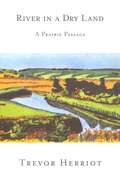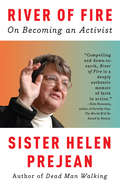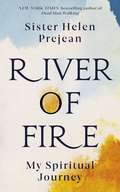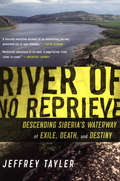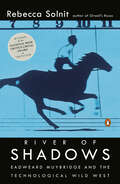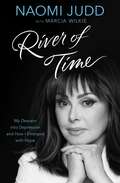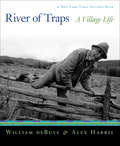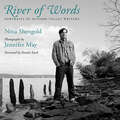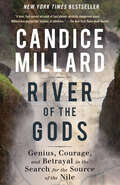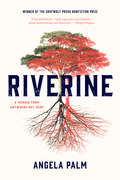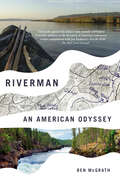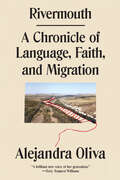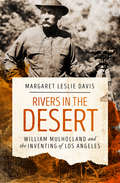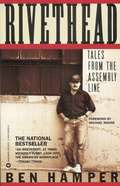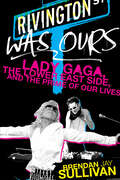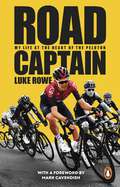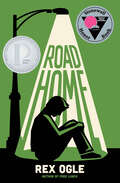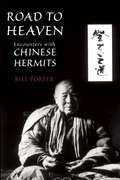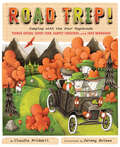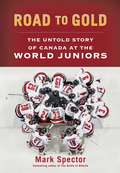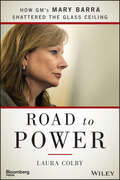- Table View
- List View
River in a Dry Land
by Trevor HerriotA landscape holds many stories, and in River in a Dry Land, Trevor Harriot's evocative book on Saskatchewan's Qu'Appelle Basin, the author-naturalist is determined to tell them all. In the summer of 1996, Herriot travelled the length and breadth of this 20,000-square-mile basin at the northeastern limits of North America's Great Plains. Though European settlers are new to this watershed, Herriot makes the point that this is not some place where nature was long "untouched by man" and recently ruined. Instead, he is more interested in the intricate relationship between people and the land that gives them life.
River of Darkness: Francisco Orellana and the Deadly First Voyage through the Amazon
by Buddy LevyThe acclaimed author of Labyrinth of Ice charts the legendary sixteenth-century adventurer’s death-defying navigation of the Amazon River.In 1541, Spanish conquistador Gonzalo Pizarro and his lieutenant Francisco Orellana searched for La Canela, South America’s rumored Land of Cinnamon, and the fabled El Dorado, “the golden man.” Quickly, the enormous expedition of mercenaries, enslaved natives, horses, and hunting dogs were decimated through disease, starvation, and attacks in the jungle. Hopelessly lost in the swampy labyrinth, Pizarro and Orellana made the fateful decision to separate. While Pizarro eventually returned home in rags, Orellana and fifty-seven men continued into the unknown reaches of the mighty Amazon jungle and river. Theirs would be the greater glory.Interweaving historical accounts with newly uncovered details, Levy reconstructs Orellana’s journey as the first European to navigate the world’s largest river. Every twist and turn of the powerful Amazon holds new wonders and the risk of death.Levy gives a long-overdue account of the Amazon’s people—some offering sustenance and guidance, others hostile, subjecting the invaders to gauntlets of unremitting attacks and signs of terrifying rituals.Violent and beautiful, noble and tragic, River of Darkness is riveting history and breathtaking adventure that will sweep readers on a voyage unlike any other.Praise for Buddy Levy and River of Darkness“In River of Darkness, Buddy Levy recounts Orellana’s headlong dash down the Amazon. Like Mr. Levy’s last book, Conquistador, about the conquest of Mexico, River of Darkness presents a fast-moving tale of triumph over seemingly insurmountable odds. . . . Though impromptu, the expedition was one of the most amazing adventures of all time.” —Wall Street Journal“An exciting, well-plotted excursion down the Amazon River with the early Spanish conquistador. . . . [A] richly textured account of the rogue, rebel and visionary whose discovery still resonates today.” —Kirkus Reviews“A rollicking adventure . . . Levy successfully conveys the Amazon’s power and majesty, while shedding light on the futility of humanity’s attempt to tame it.” —The A.V. Club
River of Fire: My Spiritual Journey
by Helen Prejean“River of Fire is Sister Helen’s story leading up to her acclaimed book Dead Man Walking—it is thought-provoking, informative, and inspiring. Read it and it will set your heart ablaze!”—Mark Shriver, author of Pilgrimage: My Search for the Real Pope Francis The nation’s foremost leader in efforts to abolish the death penalty shares the story of her growth as a spiritual leader, speaks out about the challenges of the Catholic Church, and shows that joy and religion are not mutually exclusive. Sister Helen Prejean’s work as an activist nun, campaigning to educate Americans about the inhumanity of the death penalty, is known to millions worldwide. Less widely known is the evolution of her spiritual journey from praying for God to solve the world’s problems to engaging full-tilt in working to transform societal injustices. Sister Helen grew up in a well-off Baton Rouge family that still employed black servants. She joined the Sisters of St. Joseph at the age of eighteen and was in her forties when she had an awakening that her life’s work was to immerse herself in the struggle of poor people forced to live on the margins of society. Sister Helen writes about the relationships with friends, fellow nuns, and mentors who have shaped her over the years. In this honest and fiercely open account, she writes about her close friendship with a priest, intent on marrying her, that challenged her vocation in the “new territory of the heart.” The final page of River of Fire ends with the opening page of Dead Man Walking, when she was first invited to correspond with a man on Louisiana’s death row. River of Fire is a book for anyone interested in journeys of faith and spirituality, doubt and belief, and “catching on fire” to purpose and passion. It is a book, written in accessible, luminous prose, about how to live a spiritual life that is wide awake to the sufferings and creative opportunities of our world.“Prejean chronicles the compelling, sometimes-difficult journey to the heart of her soul and faith with wit, honesty, and intelligence. A refreshingly intimate memoir of a life in faith.”—Kirkus Reviews
River of Fire: My Spiritual Journey
by Helen Prejean'Riveting ... Providing a window into the upheaval in the church during the 1960s and 70s, Prejean's engrossing memoir also fleshes out how she rose to be an influential voice within the church before becoming a renowned proponent of abolishing the death penalty. Informing and entertaining, Prejean's exceptional memoir will be of special interest to social justice advocates. Publishers WeeklyIn this revelatory, intimate memoir from the author of Dead Man Walking, America's foremost leader in efforts to abolish the death penalty shares the story of her growth as a spiritual leader, speaks out about the challenges of the Catholic Church and shows that joy and religion are not mutually exclusive. Sister Helen Prejean's work as an activist nun, campaigning to educate Americans about the inhumanity of the death penalty, is known to millions worldwide. Less widely known is the evolution of her spiritual journey from praying for God to solve the world's problems to engaging full-tilt in working to transform societal injustices. Sister Helen grew up in a well-off Baton Rouge family that still employed black servants. She joined the Sisters of St Joseph at the age of eighteen and was in her forties when she had an awakening that her life's work was to immerse herself in the struggle of poor people forced to live on the margins of society. In this honest and fiercely open account, Sister Helen writes about the relationships with friends, fellow nuns and mentors who have shaped her over the years, as well as the close friendship with a priest that challenged her vocation in the 'new territory of the heart'. The final page of River of Fire ends with the opening page of Dead Man Walking, when she was first invited to correspond with a man on Louisiana's death row.River of Fire is a book for anyone interested in journeys of faith and spirituality, doubt and belief and 'catching on fire' to purpose and passion. Written in accessible, luminous prose, it is a book about how to live a spiritual life that is wide awake to the sufferings and creative opportunities of our world.
River of No Reprieve: Descending Siberia's Waterway of Exile, Death, and Destiny
by Jeffrey TaylerThe author of In Putin’s Footsteps chronicles a deadly trek through the icy Russian region known for gulags and isolation.In a custom-built boat, Jeffrey Tayler travels some 2,400 miles down the Lena River from near Lake Baikal to high above the Arctic Circle, recreating a journey first made by Cossack forces more than three hundred years ago. He is searching for primeval beauty and a respite from the corruption, violence, and self-destructive urges that typify modern Russian culture, but instead he finds the roots of that culture—in Cossack villages unchanged for centuries, in Soviet outposts full of listless drunks, in stark ruins of the gulag, and in grand forests hundreds of miles from the nearest hamlet.That’s how far Tayler is from help when he realizes that his guide, Vadim, a burly Soviet army veteran embittered by his experiences in Afghanistan, detests all humanity, including Tayler. Yet he needs Vadim’s superb skills if he is to survive a voyage that quickly turns hellish. They must navigate roiling whitewater in howling storms, eschewing life jackets because, as Vadim explains, the frigid water would kill them before they could swim to shore. Though Tayler has trekked by camel through the Sahara and canoed down the Congo during the revolt against Mobutu, he has never felt so threatened as he does now.Praise for River of No Reprieve“This is a fiercely evocative account of an astonishing journey, wrenched out of near-disaster.” —Colin Thubron, author of In Siberia and The Lost Heart of Asia“Nonfiction adventure at its best. A page-turner from cover to cover.” —Adventure Journey“Reads like a Dantean tour of purgatory, providing a gloomily beautiful glimpse of nature—and humanity—at its bleakest edges.” —Men’s Journal
River of Shadows: Eadweard Muybridge And The Technological Wild West
by Rebecca SolnitThe world as we know it today began in California in the late 1800s, and Eadweard Muybridge had a lot to do with it. This striking assertion is at the heart of Rebecca Solnit’s new book, which weaves together biography, history, and fascinating insights into art and technology to create a boldly original portrait of America on the threshold of modernity. The story of Muybridge—who in 1872 succeeded in capturing high-speed motion photographically—becomes a lens for a larger story about the acceleration and industrialization of everyday life. Solnit shows how the peculiar freedoms and opportunities of post–Civil War California led directly to the two industries—Hollywood and Silicon Valley—that have most powerfully defined contemporary society. .
River of Time: My Descent into Depression and How I Emerged with Hope
by Marcia Wilkie Naomi JuddNaomi Judd's life as a country music superstar has been nonstop success. But offstage, she has battled incredible adversity. Struggling through a childhood of harsh family secrets, the death of a young sibling, and absent emotional support, Naomi found herself reluctantly married and an expectant mother at age seventeen. Four years later, she was a single mom of two, who survived being beaten and raped, and was abandoned without any financial support and nowhere to turn in Hollywood, CA. Naomi has always been a survivor: She put herself through nursing school to support her young daughters, then took a courageous chance by moving to Nashville to pursue their fantastic dream of careers in country music. Her leap of faith paid off, and Naomi and her daughter Wynonna became The Judds, soon ranking with country music's biggest stars, selling more than 20 million records and winning six Grammys. At the height of the singing duo's popularity, Naomi was given three years to live after being diagnosed with the previously incurable Hepatitis C. Miraculously, she overcame that too and was pronounced completely cured five years later. But Naomi was still to face her most desperate fight yet. After finishing a tour with Wynonna in 2011, she began a three-year battle with Severe Treatment Resistant Depression and anxiety. She suffered through frustrating and dangerous roller-coaster effects with antidepressants and other drugs, often terrifying therapies and, at her absolute lowest points, thoughts of suicide. But Naomi persevered once again. RIVER OF TIME is her poignant message of hope to anyone whose life has been scarred by trauma.
River of Traps
by Alex Harris William DebuysNew Mexico's Sangre de Cristo mountains are a place where two cultures - Hispanic and Anglo - meet. They're also the place where three men meet: William deBuys, a young writer; Alex Harris, a young photographer; and Jacobo Romero, an old farmer. When Harris and deBuys move to New Mexico in the 1970s, Romero is the neighbor who befriends them and becomes their teacher. With the tools of simple labor - shovel and axe, irony and humor - he shows them how to survive, even flourish, in their isolated village. A remarkable look at modern life in the mountains, River of Traps also magically evokes the now-vanished world in which Romero tended flocks on frontier ranges and absorbed the values of a society untouched by cash or Anglo America. His memories and wisdom, shared without sentimentality, permeate this absorbing story of three men and the place that forever shaped their lives.
River of Words: Portraits of Hudson Valley Writers (Excelsior Editions)
by Nina ShengoldSilver Medalist, 2011 Independent Publisher Book Awards in U.S. North-East - Best Regional Non-Fiction Category"When you truly fall in love, whether with a person or a place, you make everything else fit around it. The last eight years of my life have been a love affair with this place." — Gwendolyn Bounds, author of The Little Chapel By the RiverFor centuries, writers have drawn inspiration from the Hudson River and its surroundings. John Burroughs, James Fenimore Cooper, Washington Irving, Edna St. Vincent Millay, and Edith Wharton all lived and worked in the region immortalized by the Hudson River School of painters. In River of Words, author Nina Shengold and photographer Jennifer May explore the current crop of Hudson Valley writers, offering intimate portraits of seventy-six contemporary writers who live and work in this magnificent and storied region. Included in this rich collection of emerging and established novelists, memoirists, poets, journalists, and screenwriters are Pulitzer Prize–winners John Ashbery and the late Frank McCourt, bestselling memoirists Julie Powell and Susan Orlean, and distinguished emigres Chinua Achebe and Da Chen. What draws these writers together is not only their devotion to their art but their love and affection for the Hudson Valley. Through words and photographs, River of Words offers an inside perspective on the literary life, the craft of writing, and the pull of this distinctive American landscape.
River of the Gods: Genius, Courage, and Betrayal in the Search for the Source of the Nile
by Candice MillardThe harrowing story of one of the great feats of exploration of all time and its complicated legacy—from the New York Times bestselling author of The River of Doubt and Destiny of the Republic. <p><p>For millennia the location of the Nile River&’s headwaters was shrouded in mystery. In the 19th century, there was a frenzy of interest in ancient Egypt. At the same time, European powers sent off waves of explorations intended to map the unknown corners of the globe – and extend their colonial empires. <p><p>Richard Burton and John Hanning Speke were sent by the Royal Geographical Society to claim the prize for England. Burton spoke twenty-nine languages, and was a decorated soldier. He was also mercurial, subtle, and an iconoclastic atheist. Speke was a young aristocrat and Army officer determined to make his mark, passionate about hunting, Burton’s opposite in temperament and beliefs. From the start the two men clashed. They would endure tremendous hardships, illness, and constant setbacks. <p><p>Two years in, deep in the African interior, Burton became too sick to press on, but Speke did, and claimed he found the source in a great lake that he christened Lake Victoria. When they returned to England, Speke rushed to take credit, disparaging Burton. Burton disputed his claim, and Speke launched another expedition to Africa to prove it. The two became venomous enemies, with the public siding with the more charismatic Burton, to Speke’s great envy. The day before they were to publicly debate, Speke shot himself. Yet there was a third man on both expeditions, his name obscured by imperial annals, whose exploits were even more extraordinary. <p><p>This was Sidi Mubarak Bombay, who was enslaved and shipped from his home village in East Africa to India. When the man who purchased him died, he made his way into the local Sultan’s army, and eventually traveled back to Africa, where he used his resourcefulness, linguistic prowess and raw courage to forge a living as a guide. Without Bombay and men like him, who led, carried, and protected the expedition, neither Englishman would have come close to the headwaters of the Nile, or perhaps even survived. <p><p>In River of the Gods Candice Millard has written another peerless story of courage and adventure, set against the backdrop of the race to exploit Africa by the colonial powers. <p> <b>New York Times Bestseller</b>
Riverhead Books Summer 2013 Insider
by James Mcbride Khaled Hosseini Matthew Berry Riverhead Books Anton DisclafaniRiverhead Books is proud to present our Summer 2013 Insider which gives readers more information about the stories behind--or sometimes from within--our Summer 2013 list. Included in the Riverhead Books Summer 2013 Insider are:A Q&A with Khaled Hosseini, author of And the Mountains Echoed, an unforgettable novel about finding a lost piece of yourself in someone else. An interview with Pransky, the layabout mutt turned therapy dog at the heart of Sue Halpern's A Dog Walks into a Nursing Home: Lessons in the Good Life from an Unlikely Teacher. Ramona Ausubel's essay, "Transformation," about the inspiration for A Guide to Being Born, her enthralling new collection that uses the world of the imagination to explore the heart of the human condition. "The Story in the Mountains," an essay by Anton DiSclafani about writing her debut novel, The Yonahlossee Riding Camp for Girls, a lush, sexy evocative story of family secrets and girls'-school rituals set in the 1930s South. "Looking through the Looking Glass," an essay by Anna Badkhen on how she came to write The World is a Carpet, her unforgettable portrait of a place and people shaped by centuries of art, trade and war. A note from Mark Kurlansky about "Dancing in the Street," the iconic song he uses as a lens to examine the story of the civil rights movement's genesis in his new book, Ready for a Brand New Beat Matthew Berry's essay, "It's Fantasy Sports World, You Just Live in It," about the growing world of fantasy sports and how it has shaped his career and personal life which he details in his new book, Fantasy Life. "Noodles of the Silk Road," a field guide by Jen Lin-Liu, author of On the Noodle Road, in which she immerses herself in a moveable feast of foods and cultures and discovers some surprising truths about commitment, independence, and love A brief history of the historic raid on Harper's Ferry which plays a key role in James McBride's new novel, The Good Lord Bird, the story of a young boy born a slave who joins John Brown's antislavery crusade--and who must pass as a girl to survive. Juan Gabriel Vásquez's essay, "Memories of the Years of Chaos," about how Colombia's recent history informs his new novel, The Sound of Things FallingEach of these pieces is an engaging and informative introduction to these truly wonderful books.
Riverine: A Memoir from Anywhere but Here
by Angela PalmAngela Palm grew up in a place not marked on the map, her house set on the banks of a river that had been straightened to make way for farmland. Every year, the Kankakee River in rural Indiana flooded and returned to its old course while the residents sandbagged their homes against the rising water. From her bedroom window, Palm watched the neighbor boy and loved him in secret, imagining a life with him even as she longed for a future that held more than a job at the neighborhood bar. For Palm, caught in this landscape of flood and drought, escape was a continually receding hope. Though she did escape, as an adult Palm finds herself drawn back, like the river, to her origins. But this means more than just recalling vibrant, complicated memories of the place that shaped her, or trying to understand the family that raised her. It means visiting the prison where the boy that she loved is serving a life sentence for a brutal murder. It means trying to chart, through the mesmerizing, interconnected essays of Riverine, what happens when a single event forces the path of her life off course.
Riverman: An American Odyssey
by Ben McGrathThe riveting true story of Dick Conant, an American folk hero who, over the course of more than twenty years, canoed solo thousands of miles of American rivers—and then disappeared near the Outer Banks of North Carolina. <p><p> For decades, Dick Conant paddled the rivers of America, covering the Mississippi, Yellowstone, Ohio, Hudson, as well as innumerable smaller tributaries. These solo excursions were epic feats of planning, perseverance, and physical courage. At the same time, Conant collected people wherever he went, creating a vast network of friends and acquaintances who would forever remember this brilliant and charming man even after a single meeting. <p><p> Ben McGrath, a staff writer at The New Yorker, was one of those people. In 2014 he met Conant by chance just north of New York City as Conant paddled down the Hudson, headed for Florida. McGrath wrote a widely read article about their encounter, and when Conant's canoe washed up a few months later, without any sign of his body, McGrath set out to find the people whose lives Conant had touched--to capture a remarkable life lived far outside the staid confines of modern existence. <p><p> Riverman is a moving portrait of a complex and fascinating man who was as troubled as he was charismatic, who struggled with mental illness and self-doubt, and was ultimately unable to fashion a stable life for himself; who traveled alone and yet thrived on connection and brought countless people together in his wake. It is also a portrait of an America we rarely see: a nation of unconventional characters, small river towns, and long-forgotten waterways.
Rivermouth: A Chronicle of Language, Faith, and Migration
by Alejandra OlivaBest Nonfiction of 2023 - Kirkus &“One of the most thoughtful meditations on our nation&’s immigration policy in recent memory." —The Boston GlobeA chronicle of translation, storytelling, and borders as understood through the United States' &“immigration crisis&”In this powerful and deeply felt memoir of translation, storytelling, and borders, Alejandra Oliva, a Mexican-American translator and immigrant justice activist, offers a powerful chronical of her experience interpreting at the US-Mexico border.Having worked with asylum seekers since 2016, she knows all too well the gravity of taking someone's trauma and delivering it to the warped demands of the U.S. immigration system. As Oliva's stunning prose recounts the stories of the people she's met through her work, she also traces her family's long and fluid relationship to the border—each generation born on opposite sides of the Rio Grande. In Rivermouth, Oliva focuses on the physical spaces that make up different phases of immigration, looking at how language and opportunity move through each of them: from the river as the waterway that separates the U.S. and Mexico, to the table as the place over which Oliva prepares asylum seekers for their Credible Fear Interviews, and finally, to the wall as the behemoth imposition that runs along America&’s southernmost border.With lush prose and perceptive insight, Oliva encourages readers to approach the painful questions that this crisis poses with equal parts critique and compassion. By which metrics are we measuring who &“deserves&” American citizenship? What is the point of humanitarian systems that distribute aid conditionally? What do we owe to our most disenfranchised?As investigative and analytical as she is meditative and introspective, sharp as she is lyrical, and incisive as she is compassionate, seasoned interpreter Alejandra Oliva argues for a better world while guiding us through the suffering that makes the fight necessary and the joy that makes it worth fighting for.
Rivers in the Desert: William Mulholland and the Inventing of Los Angeles
by Margaret Leslie DavisThe rise and fall of William Mulholland, and the story of L.A.&’s disastrous dam collapse: &“A dramatic saga of ambition, politics, money and betrayal&” (Los Angeles Daily News). Rivers in the Desert follows the remarkable career of William Mulholland, the visionary who engineered the rise of Los Angeles as the greatest American city west of the Mississippi. He sought to transform the sparse and barren desert into an inhabitable environment by designing the longest aqueduct in the Western Hemisphere, bringing water from the mountains to support a large city. This &“fascinating history&” chronicles Mulholland&’s dramatic ascension to wealth and fame—followed by his tragic downfall after the sudden collapse of the dam he had constructed to safeguard the water supply (Newsweek). The disaster, which killed at least five hundred people, caused his repudiation by allies, friends, and a previously adoring community. Epic in scope, Rivers in the Desert chronicles the history of Los Angeles and examines the tragic fate of the man who rescued it. &“An arresting biography of William Mulholland, the visionary Los Angeles Water Department engineer . . . [his] personal and public dramas make for gripping reading.&” —Publishers Weekly &“A fascinating look at the political maneuvering and engineering marvels that moved the City of Angels into the first rank of American cities.&” —Booklist
Rivethead: Tales from the Assembly Line
by Ben HamperA former "shoprat" in a Michigan auto plant offers a gritty account of life in the world of manufacturing, on and off the assembly line.
Rivington Was Ours: Lady Gaga, the Lower East Side, and the Prime of Our Lives
by Brendan Jay Sullivan“Equal parts insightful, funny, romantic and poetic, this is a book that’s not just about Gaga but about the magic of the city.” —Captain” Kirk Douglas, guitarist for The RootsBrendan Jay Sullivan was an up-and-coming DJ in New York City when he met Stefani Germanotta, then a struggling artist, in 2006. She was a go-go dancer who sewed her own outfits but had bigger ambitions—she wanted nothing less than to take over the music world.In this intimate portrait of the budding star, the author describes afternoons sitting with Gaga on the floor of her bare Lower East Side apartment, drinking wine from pint glasses and plotting out the pop stardom that awaited her.Filled with stories of love and heartbreak among Gaga and Sullivan and their circle of aspiring musicians and performers, and set against the vibrant backdrop of the downtown bars and parties of the mid-aughts, Rivington Was Ours is both a love letter to New York and a glimpse behind the veil of one of the biggest musical icons of her generation.“Entertaining . . . An intimate portrait of a specific time—before stardom struck—and a particular place. Fans of Gaga and the downtown New York music scene will find this fascinating.” —Booklist “A fascinating and vivid insight into the cauldron that formed a great musician.” —Andy Rourke, bass guitarist for The Smiths“Brendan Jay Sullivan is a writer’s writer. Yes, he’s that good.” —Gary Shteyngart, New York Times–beststelling author of Super Sad True Love Story“A touching memoir.” —New York Post
Road Captain: My Life at the Heart of the Peloton
by Luke RoweFEATURING A FOREWORD FROM MARK CAVENDISH AND CONTRIBUTIONS FROM GERAINT THOMAS, CHRIS FROOME AND ROD ELLINGWORTH.A rare insight into the heart of pro cycling and the inner workings of the peloton, from Team Sky and Ineos Grenadiers legend, Luke Rowe.There’s one well-established truth in professional cycling: the strongest always wins. Yet in a sport of champions, victory is only possible as a team. At the heart of that team effort, that unity, is the road captain.After more than a decade as the pre-eminent road captain in professional bike racing, Luke Rowe reveals here for the first time the intricacies of that role. As he lifts the lid, he provides the ultimate insider’s view on racing tactics and strategy within the professional peloton. He gives readers an unprecedented insight into what exactly is going on within that pulsing mass of athletic power and state-of-the-art machinery, seen through the eyes of the rider tasked with leading his team to glory.Featuring exhilarating stories from his years at Team Sky and Ineos Grenadiers – where he played a fundamental role in the team’s dominance at the Tour de France, leading Chris Froome, Geraint Thomas and Egan Bernal to their Tour victories – Luke shows what it’s like to manage a road race unfolding at 60km/h. As he points out, it is ‘like playing chess on wheels’.Road Captain immerses readers in the team dynamics, tactical complexities and split-second decisions vital to success in professional cycling. It discloses the mental and physical battles taking place within a group of riders, and reveals how the biggest bike races are won.
Road Dog: Life and Reflections from the Road as a Stand-up Comic
by Dov DavidoffRoad Dog is comedian, actor, and writer, Dov Davidoff's unflinching memoir told through reflections of twelve months on the road. Davidoff travels across the country from college campuses to local theaters doing stand-up comedy and telling it like it is. He's been known to wax poetic about everything from encounters with large fake breasts, to people who have too many kids, to magnum condoms the size of CD cases. He is hilarious and relatable and will have you laughing at yourself in no time. But there's more to the road dog life than TV features and sold out comedy shows, there's a dark underbelly and Dov knows it well. His memoir chronicles the highs and often very low lows of performance life with honesty, clarity, and humility. Dov takes readers from his fractured childhood days spent in a New Jersey junkyard with a gruff Jewish father and commune-loving hippie Protestant mother to the intense hyperactive persona that his fans know and expect discussing the relationships, drugs, and demons that he has fought along the way. With an eye for self-reflection, and a penchant for hilarious irony, Dov pulls back the curtain on a life hard-made on the road.
Road Home
by Rex OgleA Printz Award Honor Book A Stonewall Book Award Honor Book An Amazon Best Book of the Year A Chicago Public Library Best of the Best Book of the Year Horn Book Fanfare Best Books of the Year A Kirkus Reviews Best Book of the Year A School Library Journal Best Book of the Year This final, essential chapter in Rex Ogle’s memoir trilogy recounts being forced from his home and living on the streets after his father discovered he was gay. When Rex was outed the summer after he graduated high school, his father gave him a choice: he could stay at home, find a girlfriend, and attend church twice a week, or he could be gay—and leave. Rex left, driving toward the only other gay man he knew and a toxic relationship that would ultimately leave him homeless and desperate on the streets of New Orleans. Here, Rex tells the story of his coming out and his father’s rejection of his identity, navigating abuse and survival on the streets. Road Home is a devastating and incandescent reflection on Rex’s hunger—for food, for love, and for a place to call home—completing the trilogy of memoirs that began with the award-winning Free Lunch.
Road To Heaven: Encounters With Chinese Hermits
by Red Pine Bill PorterIn 1989, Bill Porter, having spent much of his life studying and translating Chinese religious and philosophical texts, began to wonder if the Buddhist hermit tradition still existed in China. At the time, it was believed that the Cultural Revolution had dealt a lethal blow to all religions in China, destroying countless temples and shrines, and forcibly returning thousands of monks and nuns to a lay life.
Road Trip!: Camping with the Four Vagabonds: Thomas Edison, Henry Ford, Harvey Firestone, and John Burroughs
by Claudia FriddellJoin Thomas Edison, Henry Ford, Harvey Firestone, and John Burroughs on their pioneering camping trips during the early 1900s in this energetic and entertaining nonfiction picture-book adventure.After years of inventing things that other people needed, Thomas Edison and Henry Ford realized there was something they needed—a vacation! So, the famous inventors packed up Ford's Model T and invited their good friends Harvey Firestone and John Burroughs to join them as "the Four Vagabonds" hit America's back roads to enjoy the country's natural beauty, fireside chats, and frolicking fun with friends—all while inspiring future generations to invent camping adventures of their own.&“Buckle yourself in as Claudia Friddell and Jeremy Holmes take you on a fun, creative, and certainly unique road trip with America&’s most famous vagabonds—Thomas Edison, Henry Ford, Harvey Firestone, and John Burroughs. The colorful and spirited illustrations, the stories of the Vagabond&’s bivouacking travels and campsite escapades, and the well-researched bibliography makes Road Trip! a great addition to any child&’s library!&” —Matt Andres, curatorial registrar, Edison and Ford Winter Estates
Road to Gold: The Untold Story of Canada at the World Juniors
by Mark SpectorFrom bestselling author Mark Spector comes the behind-the-scenes story of the Canadian World Junior program&’s journey from obscurity to the international powerhouse that it is today.On the world junior hockey stage today, Canada is known as the team to beat. They hold the record for the most gold medals won (seventeen since the tournament&’s inception), their games draws millions of fans each year, and the tournament serves as a showcase for each year&’s best talent. But things weren&’t always so rosy. For years, Canada languished in obscurity at the World Juniors. Wearing the red-and-white wasn&’t a mark of honour but merely a sideshow to the players, owners resented the interruption to their league operations, and Canada was an afterthought at the tournament. Canada was supposed to be better at hockey than any nation on earth—how could the team languish in such obscurity? So, the team set out on a reclamation mission. The Program of Excellence was born, and with it, a new hope for hockey&’s future in Canada. No more would Canada be content with merely showing up. Instead, each year, the country would send its best talent—from Gretzky to Lemieux to Crosby to McDavid—to reclaim its spot at the top of the hockey world. Tracing the owner disputes, off-ice antics, and riveting on-ice action of nearly forty years at the World Juniors—and full of inside stories from hockey greats—this is hockey history as you&’ve never seen it before. Funny, smart, and clear-eyed, Mark Spector traces the remarkable rise of the Canadian World Junior program and shows how the World Juniors created not just a new team, but a new dream for the sport.
Road to Power
by Laura ColbyFollow a pioneer's journey from factory floor to CEO Road to Power is the story of how Mary Barra droveherself to the pinnacle of a company that steers the nation'swealth. Beginning as a rare female electrical engineer and daughterof a General Motors die maker, Barra spent more than thirty yearsbuilding her career before becoming the first woman to ever lead aglobal automaker. With $155 billion in sales and 200,000 employees,GM is widely considered to be a proxy for the U.S. economy, makingBarra's position arguably the most important corporate role a womanhas ever held. This book describes the personal character, choices,and leadership style that enabled her to break through the glassceiling.When 52-year-old Mary Barra was named CEO of General Motors in2013, only people outside of the company were surprised. She haddone everything from working on the factory floor to overseeingmanufacturing, from improving union relations to paring downbureaucracy, and from running human resources to helping drag thecompany back from its 2009 bankruptcy. This book details each stepof her career, and the lessons she learned along the way.Learn how Mary Barra's willingness to take on diverseassignments helped steer her career trajectoryExamine the fine details of Barra's management style and herability to relate to colleaguesDiscover the qualities and experiences Barra had that drove herto lead this male-dominated professionStudy the valuable lessons Barra learned at each stage in herprofessional life, and why they stuck with her throughout herjourney to the topBarra is most certainly a pioneer for women in business, butshe's also a living lesson as to how far the right outlook, skills,and drive can take you in your career. Road to Powerexplores the talent and the mindset that got her all the way to thetop.
Road to Rouen
by Ben HatchFrom the bestselling author of ARE WE NEARLY THERE YET? (Radio 2 Book of the Year & voted Amazon Customers' Fave Kindle Read 2011) comes a new hilarious and touching story of travel chaos.Chosen as one of Amazon's Best Kindle Books of 2013 Ben Hatch is on the road again. Commissioned to write a guidebook about France (despite not speaking any French) he sets off with visions of relaxing chateaux and refined dining. Ten thousand miles later his family's been attacked by a donkey, had a run-in with a death-cult and, after a near drowning and a calamitous wedding experience involving a British spy, his own marriage is in jeopardy. A combination of obsessions about mosquitoes, French gravel and vegetable theme parks mean it's a bumpy ride as Ben takes a stand against tyrannical French pool attendants, finds himself running with the bulls in Pamplona and almost starring in a snuff movie after a near fatal decision to climb into a millionaire's Chevrolet Blazer.Funny and poignant, Road to Rouen asks important questions about life, marriage and whether it's ever acceptable to tape baguette to your children's legs to smuggle lunch into Disneyland Paris.
